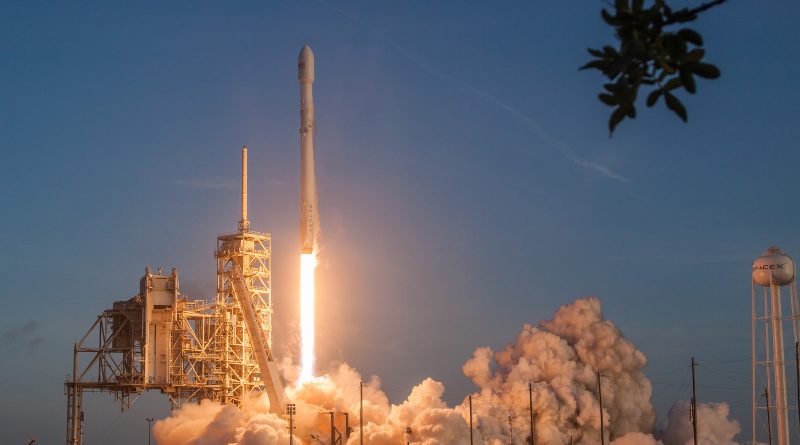Falcon 9 Soars to Orbit with Secret Government Satellite, 1st Stage Lands at Cape Canaveral
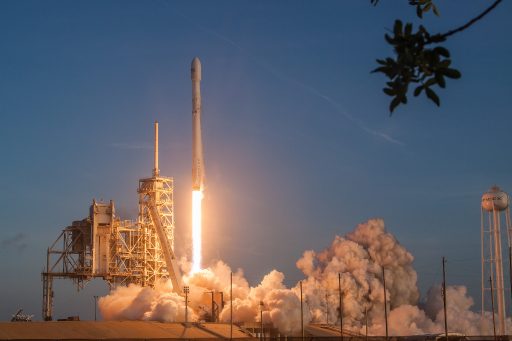
A SpaceX Falcon 9 rocket thundered away from Florida’s Space Coast on Monday on its first top-secret satellite delivery for the U.S. National Reconnaissance Office, operator of the country’s spy satellite fleet.
Although the NROL-76 payload hidden under Falcon’s fairing and its orbital destination are closely guarded secrets, clues emerging prior to launch narrowed the satellite’s identity down to an optical or radar mission demonstrating new technologies for future reconnaissance missions of the NRO.
The 70-meter tall rocket came to life at 11:15 UTC, blasting off from Launch Complex 39A at the Kennedy Space Center to accelerate away from Florida to the north-east – a trajectory consistent with an inclined Low Earth Orbit. The rocket’s first stage dropped away after a particular short burn of 139 seconds before the second stage took over to boost NROL-76 into its classified orbit.
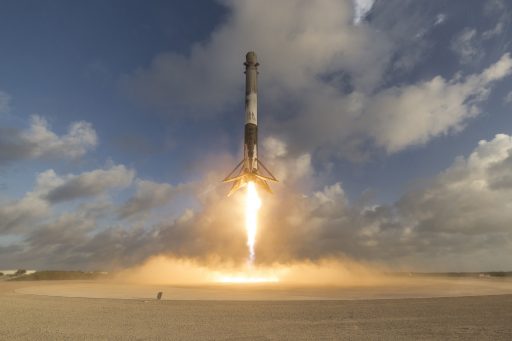
Falcon 9 flew into the usual news blackout of NRO missions when the payload fairing separated just shy of three minutes into the flight to allow the classified satellite to reach its secret orbital destination without the public watching.
Hauling its classified payload toward orbit, the Falcon 9 booster returned to Cape Canaveral to make the fourth land-based landing in Falcon’s career while the second stage of the rocket will be tasked with a deorbit maneuver later – leaving no traces of the day’s launch in orbit except for the NROL-76 payload that will operate in complete secrecy.
Monday’s launch was the 33rd flight of the SpaceX Falcon 9, the 13th for the Falcon 9 Full Thrust version and the fifth of 2017 as SpaceX continues efforts to step up the company’s launch rate to tackle a busy manifest of missions. It was the tenth successful recovery of a Falcon 9 booster, the fourth via a Landing Zone-1 landing, bringing the overall tally to 10 successful landings out of 15 tries.
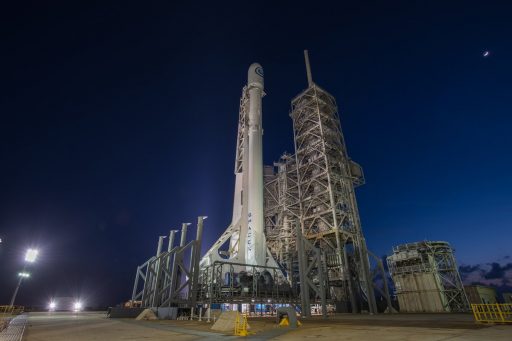
Confirmation of launch success – provided by SpaceX CEO Elon Musk 21 minutes after liftoff – will be the last heard of NROL-76 from official channels given the typical shroud of secrecy for NRO missions, however, a worldwide network of satellite trackers is ready to spring into action to provide visual observations and radio tracking to spot the classified spacecraft in orbit and monitor any and all activities that could reveal the satellite’s purpose.
The U.S. National Reconnaissance Office is one of the big five intelligence agencies in the United States, tasked with the operation of all U.S. reconnaissance satellites and the distribution of image, signals and signature intelligence to the CIA, DIA and NGA. As a three-letter intelligence organization itself, the NRO goes through great lengths to keep its activities secret, including the identity of all its satellites that fly under an arbitrary numbering system to disguise any clues to their mission.
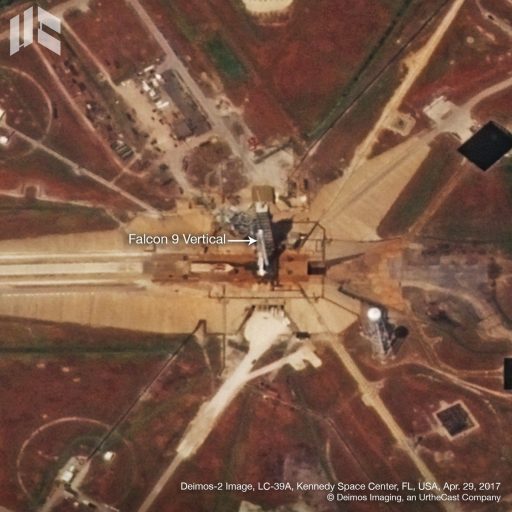
The NRO was founded in 1961 and operated in complete secrecy for three decades until its existence was first acknowledged and launches were announced in advance in the 1990s.
NRO’s secret-keeping policy has delivered mixed results this far as occasional leaks provide insights into ongoing programs and satellites can be matched to these programs through clues in their launch vehicle configuration, ascent path and orbital activity. As is normal for NRO launches, the agency’s secrecy only fueled speculation on NROL-76 and is purpose in the weeks ahead of launch.
Initially, the only major clue as to where the satellite was headed were two safety zones identified for this mission – one just off the coast of Florida revealing the mission’s north-easterly launch azimuth and the second stage deorbit area over the Indian Ocean. The north-easterly launch trajectory ruled out a Geostationary delivery but left several orbital scenarios on the table including a Low Earth Orbit and a Molniya Transfer Mission targeting an elliptical orbit peaking over the northern hemisphere.
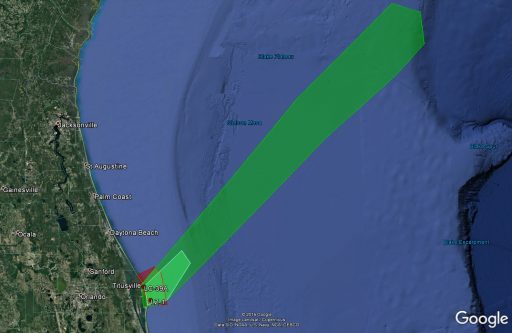
The launch azimuth would take the vehicle into a 51-degree orbit, however, dogleg maneuvers during launch and future maneuvering by the spacecraft could easily adjust the inclination to over 60 degrees. This leaves a range of non-synchronous Low Earth Orbits as options for NROL-76 as well as a highly elliptical Molniya Orbit suitable for signals-intelligence, communications and missile warning satellites.
More information could be extracted from the peculiar way the NROL-76 mission was contracted: SpaceX was awarded the contract for the NROL-76 launch back in 2013 or even as early as 2012, but not through the NRO directly. At the time, SpaceX was still in the midst of switching from the original version of Falcon 9 to the much improved v1.1 which had not yet been certified to compete for national security missions.
However, the NRO could contract with a private firm for the whole package of satellite manufacture & launch services, making this a commercial mission that SpaceX was eligible for and circumventing the Air Force certification process.

According to NRO officials, the launch contract was secured through Ball Aerospace – most likely in a ‘delivery in orbit’ contract scheme under which Ball is responsible for satellite development, production, testing, launch and in-orbit testing before handing the product to the customer.
Ball has built a reputation for small- and medium-class LEO satellites and high-resolution optical instruments flying on Earth-orbit and interplanetary missions – providing some insight into what NROL-76 might be carrying.
The NROL-76 patch features a pair of explorers – Lewis & Clark – one peering into the distance with a telescope while the other intently looks toward the same direction with a rifle at the ready. The words ‘Explore – Discover – Know’ are inscribed on the patch which could indicate NROL-76 will be used as a technology demonstration, exploring a future sensor for intelligence-gathering craft, potentially making use of new technology or a novel wavelength band not previously used in reconnaissance.
The scope and rifle on the patch could also imply the satellite will take on a tactical role within the NRO’s spying fleet.
A previous NRO Low Earth Orbit tech demonstration mission, USA-193, set out to demonstrate a new radar payload to retire risk for the agency’s Topaz radar constellation prior to its first launch. However, within hours of the craft’s December 2006 launch, the satellite failed and could not be recovered, leaving the 2,300-Kilogram vehicle in an uncontrollable state and headed for re-entry within two years of launch. In February 2008, USA-193 was purposefully destroyed by an SM-3 missile when it had decayed to a point where most debris created by the strike would re-enter within a period of days.
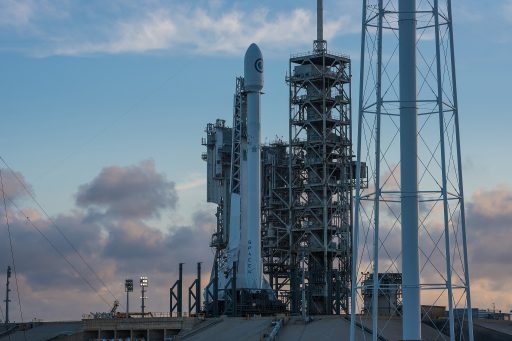
Although the architecture under which USA-193 was developed has largely been dismantled with the cancellation of the Future Imagery Architecture, a follow-on mission of similar nature but with different sensor equipment seems within reason given the NRO has shown desire in the past to test out systems for critical future missions beforehand – as illustrated by USA-193 and, more recently, USA-225 that launched in 2011 as a low-cost, small spacecraft mission to test out new technologies.
If following a similar architecture as USA-193, NROL-76 would be expected to show up in an orbit of around 360 Kilometers at an inclination of 58°.
Because Monday’s launch was contracted as a commercial mission, the Federal Aviation Administration was the primary licensing body and the launch license for the mission was made public, confirming Falcon 9 would be headed into a Low Earth Orbit, eliminating any remaining doubts as to whether a Molniya mission was still on the table.
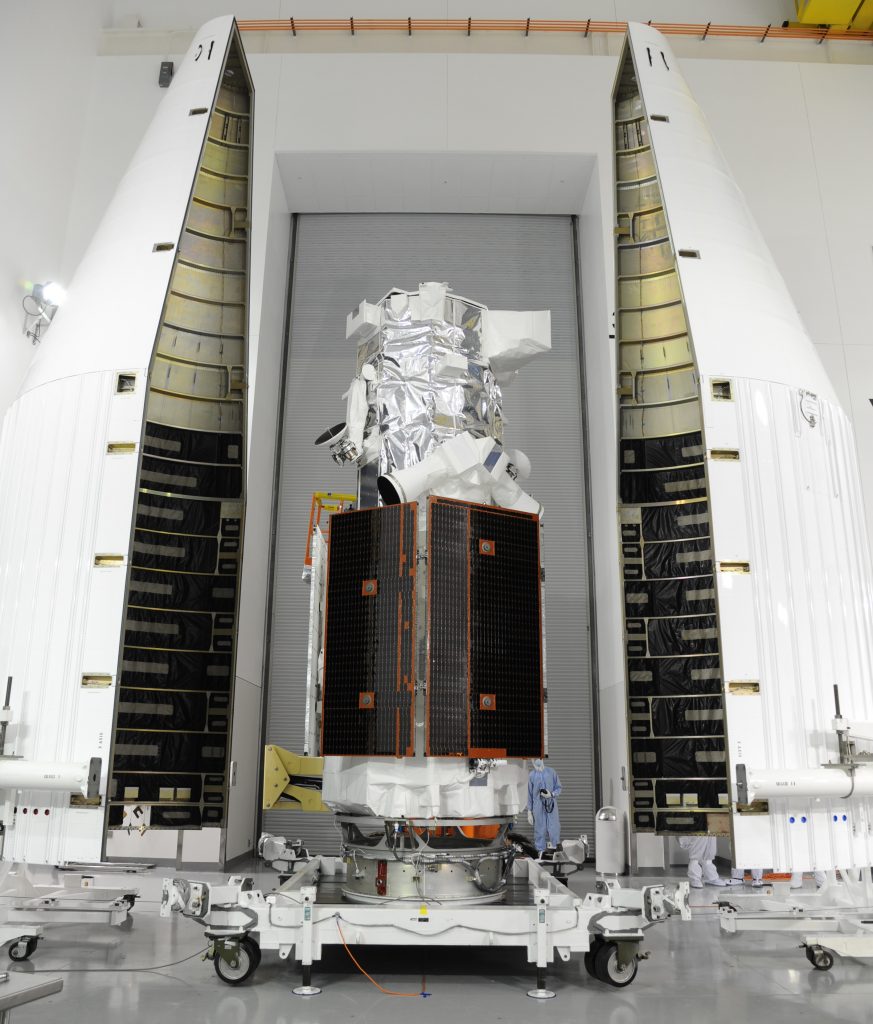
A LEO mission is also consistent with the NROL-76 launch profile – calling for a particularly short first stage burn and payload fairing separation two minutes and 48 seconds into the flight. This type of lofted trajectory indicates a steep ascent during first stage and the initial portion of the second stage to achieve a circular Low Earth Orbit with a single upper stage burn. A similar profile was flown by Falcon 9 in 2015 with the second group of Orbcomm G2 satellites as opposed to a two-burn mission, e.g. Iridium & Jason-3 which used less steep ascent profiles into an initial, elliptical parking orbit.
Ball Aerospace’s product palette only has two candidates that would fit this mission – the BCP-5000 and BCP-4000 satellite platforms which are the company’s largest satellite buses and the only that would justify the use of the powerful Falcon 9 launcher.
BCP-5000 is optimized for large optical payloads and has flown three times to date for DigitalGlobe’s WorldView program. These satellites weigh in at up to three metric tons and offer accommodations for high-resolution optical payloads in a variety of wavelength ranges. Of particular interest for optical collection is BCP’s high agility through the use of Control Moment Gyros that allow the satellite to move from one target to the next within five seconds. WorldView-3, the most recent BCP-5000, achieves a ground resolution of 31 centimeters whereas the NRO’s powerful Keyhole satellites are rumored to have a resolution around 10-15 centimeters.
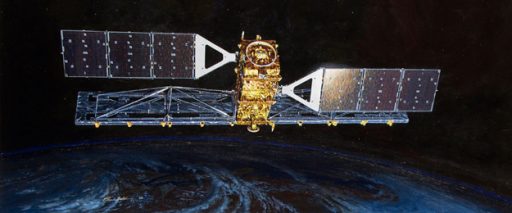
BCP-4000 is optimized for Synthetic Aperture Radar Payloads, having flown only once before on the RadarSat-1 mission of the Canadian Space Agency that carried a Canadian-built radar system primarily used for remote sensing.
Ball’s satellite platforms have been highly regarded in the industry for their reliability, often surpassing their expected service lives by many years as shown by RadarSat-1 that operated for 17 years, 12 years longer than initially planned, and the smaller QuickBird imaging satellite, in service eight years longer than expected. Longevity is typically an important aspect of NRO missions that often operate for a decade or longer.
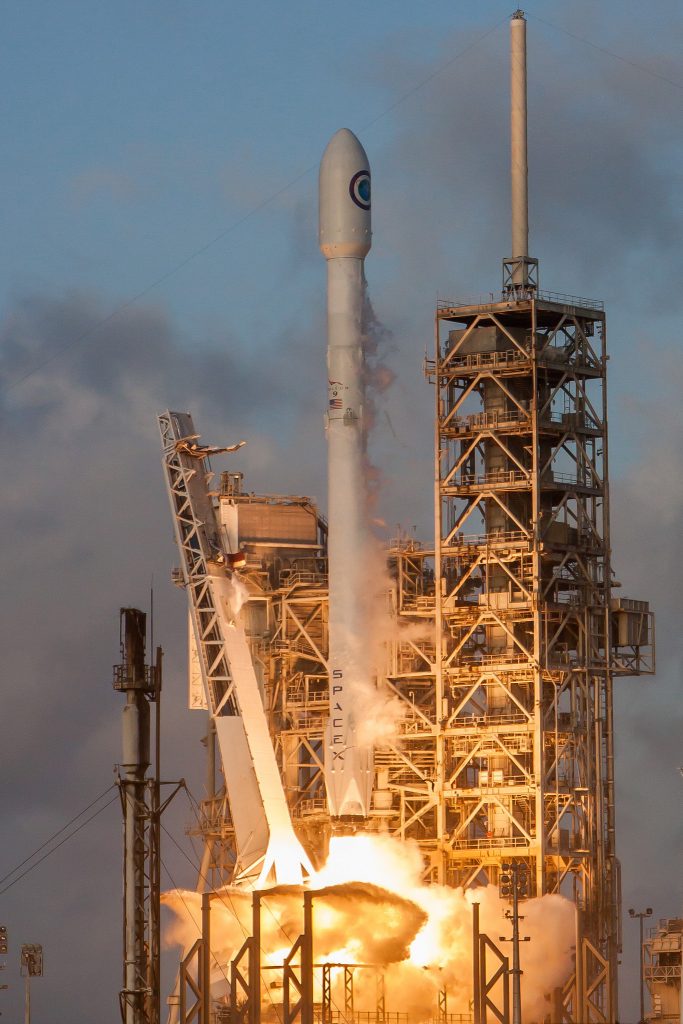
What exactly NROL-76 will be testing remains to be seen based on the behavior it exhibits in orbit. A radar mission would be easily identifiable by satellite trackers as the deployment of the large SAR antenna would cause a significant increase in the satellite’s brightness in the days or weeks after launch, but will require a quick identification of the spacecraft after orbital insertion.
Monday’s launch took place from LC-39A at the Kennedy Space Center, the former Saturn V and Space Shuttle launch pad that is currently SpaceX’s only East Coast launch site until SLC-40 a few Kilometers south can be returned to service after last September’s Falcon 9 testing accident.
Coming back from Sunday’s launch scrub, engineers replaced a suspect sensor on the rocket’s first stage before teams re-started countdown operations in the overnight hours.
The countdown was very quiet as Falcon 9 went through several hours of systems checks while teams buttoned up the launch facility before the vehicle headed into propellant load setup. With no known issues on the two-stage rocket, a mostly favorable weather forecast and an operational rage, controllers provided a unanimous GO to press into the fast-paced tanking sequence at T-70 minutes.
As the countdown switched into automatic mode, Falcon 9 entered Rocket Propellant 1 loading to fill the two stages with around 155 metric tons of the densified fuel, chilled to -7°C. Liquid Oxygen systems first went through a chilldown before the sub-cooled LOX began flowing into the tanks at T-45 minutes to feed Falcon 9 with a total of 360 metric tons of the -207°C oxidizer. Prop load went through an elaborate throttling sequence to ensure both stages achieved flight mass with as little margin as possible prior to T-0 to prevent the cooled propellants from warming excessively.
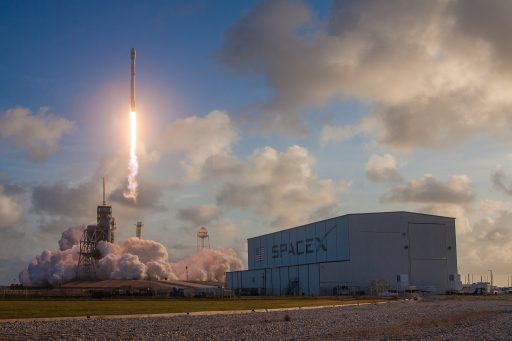
The pace of countdown events accelerated in the last ten minutes when Falcon 9 started exercising its various engine valves, put its thrust vector controllers through a final test and initiated the chilldown of the nine Merlin 1D engines on the business end of the vehicle. The completion of tanking was confirmed at T-2 minutes and final approval for launch was given by the Eastern Range and Launch Director before Falcon 9 assumed full control of the countdown at the T-1 minute mark.
A self-igniting mixture was injected into the engines three seconds prior to liftoff and Falcon 9 throttled up to a launch thrust of nearly 700 metric ton-force under the close watch of computers that only allowed the vehicle to leave the ground when all engines were at nominal operating parameters. Rising from the ground at 11:15:00 UTC, 7:15 a.m. local time, Falcon 9 balanced in a vertical position for the first 16 seconds of the mission before beginning its turn downrange, departing the Cape to the north-east.
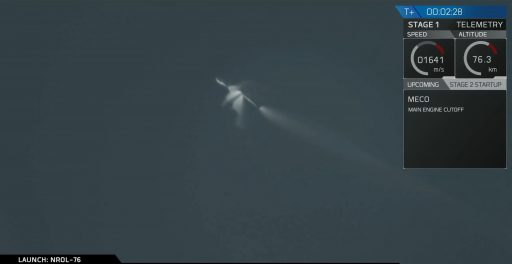
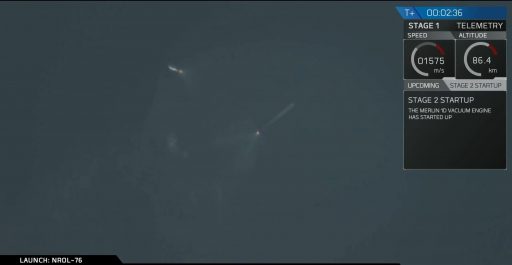
Accelerating uphill, Falcon 9 consumed 2,450 Kilograms of propellant per second, passing the speed of sound just after T+1 minute and encountering Maximum Dynamic Pressure 68 seconds after liftoff, earlier than any mission before owed to the particular trajectory chosen for NROL-76. As the first stage throttled up after passing MaxQ, Stage 2 entered its final preparations for ignition by chilling down its MVac engine.
This mission had a shorter first stage burn time than any Falcon 9 flight before, shutting down after 139 seconds. The three previous RTLS recovery missions – OG2-2 in 2015 and Dragon SpX-9 and 10 in 2016 & ’17 fired the booster 140 and 141 seconds for the primary mission, showcasing the performance margins associated with the NROL-76 mission.
Three seconds after MECO, the first stage separated by means of four pneumatic pushers that sent it clear of the second stage for ignition of the 95,000-Kilogram force MVac engine two minutes and 29 seconds into the flight. Another 20 seconds later, Falcon 9 had reached 110 Kilometers in altitude, making it safe for the payload fairing to be separated to shed no-longer-needed weight.
After payload fairing separation, the mission headed into the typical News Blackout of NRO missions with no more public information on the progress of NROL-76 with the exception of a confirmation of launch success coming later in the day on Monday.
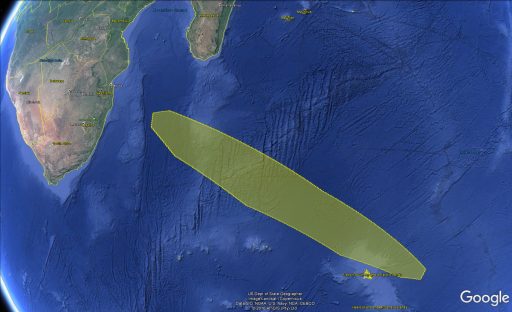
What the second stage was up to after heading out of public sight remains open for speculation and depends on the target orbit of the mission. For a LEO delivery up to around 600-800 Kilometers in altitude, a single burn of the MVac engine should suffice while any higher LEOs would likely employ a two-burn design with circularization after half an orbit of coasting. The type of lofted mission profile used by Falcon 9 would suggest a direct injection in which case spacecraft separation would occur less than 15 minutes after launch – in line with Elon Musk’s Tweet of ‘a good launch’ after 21 minutes.
The deorbit of the second stage 3+ hours after launch is unique for a SpaceX mission to LEO that normally deorbit the upper stage on the first revolution. Though, SpaceX may want to test longer-duration operation of the stage for certification of Falcon 9 for direct GEO injections in the future. This mission, given the vast amount of unused performance, is a prime candidate for experimentation with the second stage such as management of propellant temperatures over an extended coast duration and start-up characteristics of the MVac engine after a multi-hour coast.
Depending on the trajectory of the mission, re-entry of the second stage could be visible from the southern half of Madagascar in twilight conditions.
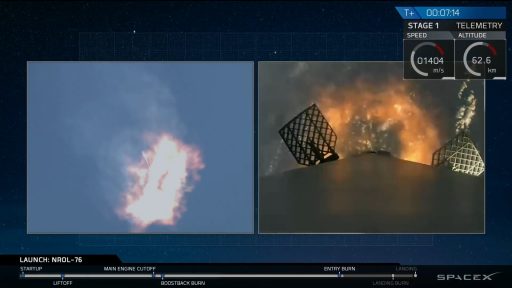
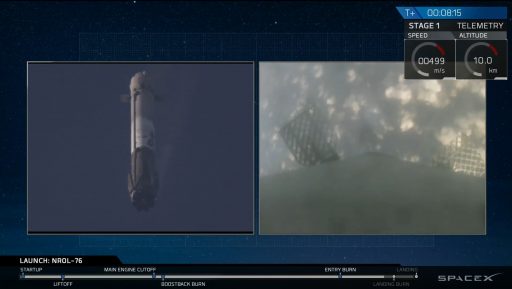
Satellite trackers are facing an interesting challenge with this mission as there are many orbital scenarios that seem to fit with the criteria imposed by the known safety zones for this mission.
A Low Earth Orbit of 360 Kilometers fits with the safety zones and the timing of the second stage deorbit and would also agree with the hypothesis of a USA-193-type mission, although analysis has also shown that an orbit of ~850 Kilometers can also fit the characteristics of this mission and would be a close match with the orbit of previous Ball Aerospace satellites. The inclination of the injection orbit could be anywhere between 50 and 60 degrees, modified via dogleg or plane change maneuvers.
Nevertheless, a worldwide community of trackers is at the ready to spot the new satellite in orbit to begin monitoring its moves that could deliver more insight into the craft’s purpose.
For the first stage, separation marked the start of its fast-paced return sequence. At the moment of separation, the vehicle was 70 Kilometers in altitude and traveling 1.68km/s, slightly different starting conditions from previous missions given this flight’s lofted trajectory.
Immediately after separation, the first stage moved to an engines-first attitude and re-lit three of the Merlins at T+2:36 for a full boost-back maneuver, accelerating toward Landing Zone 1 at Cape Canaveral just around 15 Kilometers south from where Falcon 9 blasted off.
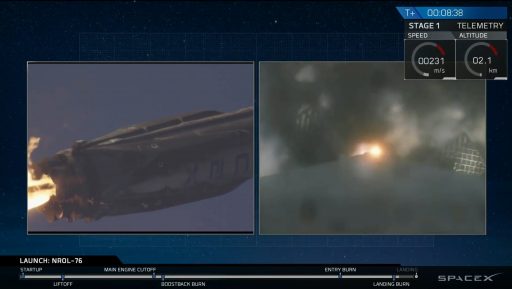
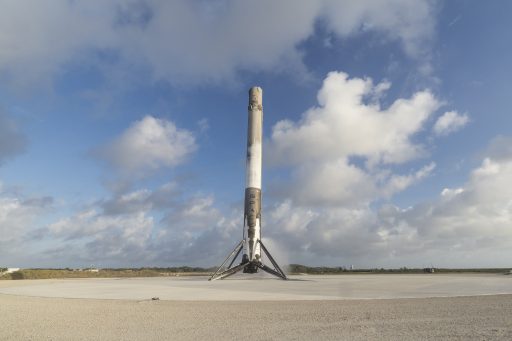
After completion of the burn, the booster again used its cold gas thrusters to maneuver into the correct posture for the Entry Burn that started just after T+7 minutes and lasted 25 seconds to slow the vehicle down and create more benign entry conditions.
The stage made the typical pitch maneuver just before entering the peak heating phase of the entry, using its four actuated grid fins to control its three-axis orientation. The fins were in action for nearly a minute of unpowered descent, taking the booster through the transsonic phase and tasked with flying out any errors to enable the booster to reach LZ-1.
Eight minutes and 29 seconds after blasting off, Falcon 9 was inbound again, firing up its center engine that was set for some heavy-throttling to manage the final landing maneuver in hoverslam fashion. Transitioning to a vertical descent, Falcon 9 deployed its four landing legs and the 47-meter tall booster touched down eight minutes and 59 seconds after liftoff – mastering its fourth land-based landing and SpaceX’s tenth successful recovery overall.
Given the energy involved in this mission, the booster is a prime candidate for one of the re-flight missions SpaceX is planning later this year to get closer to the ultimate goal of regularly re-using cores over many mission cycles.

